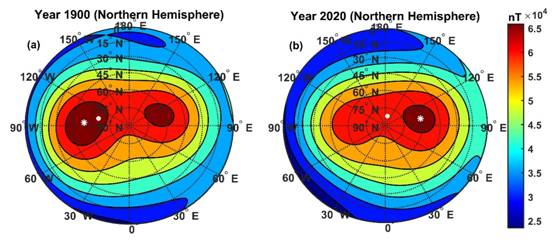
New Delhi, India – January 29, 2025: The migration of Earth’s north magnetic pole from Canada to Siberia has significantly impacted the behavior of charged particles in the magnetosphere, a recent study reveals. Conducted by researchers at the Indian Institute of Geomagnetism, the study sheds light on the implications of these changes for space weather and satellite operations.
Earth’s magnetic field, a dynamic shield generated by the planet’s core, has been shifting for over a century. Once located in Canada, the north magnetic pole has moved steadily toward Siberia, accelerating to an estimated speed of 50 kilometers per year by 2020. This shift affects the distribution of charged particles, such as protons and electrons, in the Earth’s radiation belts, which in turn influences phenomena like the aurora and satellite performance.
Using advanced simulations based on the IGRF-13 (International Geomagnetic Reference Field) model, researchers Ayushi Srivastava, Dr. Bharati Kakad, and Dr. Amar Kakad studied the changes in the altitudes of energetic protons over the last century. The results, published in Advances in Space Research, reveal that particles over Canada in 1900 remained at higher altitudes due to a stronger magnetic field. However, by 2020, as the pole moved toward Siberia, the magnetic field weakened over Canada and strengthened in Siberia.
The stronger Siberian magnetic field gradients created forces that deflected charged particles outward, preventing them from diving deeper into Earth’s atmosphere in the Siberian region. This led to a rise in penetration altitudes by 400 to 1,200 kilometers for certain particles.
Also Read: ISRO’s 100th Launch Signals a New Era in India’s Space Exploration
These findings have tangible implications for satellites in polar orbits, which encounter varying atmospheric densities caused by charged particle activity. Changes in atmospheric drag can alter satellite trajectories, while particle collisions can heat the atmosphere, further impacting satellite operations.
This study enhances understanding of particle dynamics and geomagnetic variations, aiding in the prediction of space weather events and the protection of satellite systems from adverse effects.
Source:PIB


